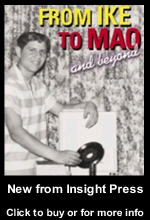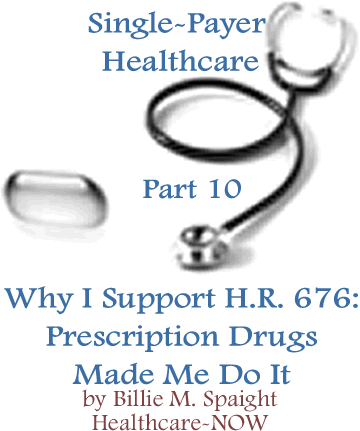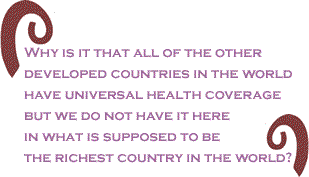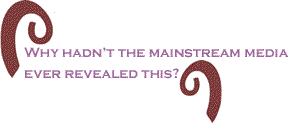
|
|||||||||||||||||||||
 |
|||||||||||||||||||||

|
|
|
Note: Marilyn Clement, founder and National Coordinator of Healthcare-NOW!, passed away on Monday, August 3, 2009. Sister Marilyn was the inspiration for the BC series on Single_Payer Healthcare. We will miss her friendship, support and hard work for the movement for economic justice, social justice and peace. Click here for more about her life. Healthcare. The topic is on everybody’s tongue today. But when I first started worrying about it, virtually no one was interested in it. I’d never heard of John Conyers, Jr., and H.R. 676. If I had, I would have been working for single-payer, universal healthcare cause a lot sooner. I had always been well-covered on my jobs and, when I got married, it was easy to put my husband on a plan. As a dual disability family, Jimmy and I were covered for doctors, prescription drugs, and testing. We had what was known as an 80-20 plan—we paid 20% of costs and the insurance company paid the rest. Not one cent came out of my paycheck. It’s true that hearing aids weren’t covered but I got good discounts from the New York League for the Hard of Hearing for my hearing aids. Things were inexpensive back then, so this worked out fine. Healthcare wasn’t a concern. Jimmy was only on two prescription drugs and I rarely needed any. Even during periods of unemployment, things were not too bad coverage-wise. After signing up for unemployment, I would just walk over to the convenient desk right in the unemployment office, and sign up for Medicaid. I’d get the card in the mail and use it whenever I needed it. It was even good for getting free food when they would give it away at various churches.
An Unraveling Safety Net In the mid-1980s, the safety net was being torn up. Every so often, we would notice things that were not fair, such as having to wait six months to get coverage for preexisting conditions or small businesses with chronically ill employees not being able to purchase coverage. We complained about it, but we always had a way to compensate. If one of us wasn’t covered, the other one was. Until I lost my job in the mid-1980s. . . . That’s when we saw what paying out-of-pocket really meant. But let me be upfront here: This isn’t a tale of horror. It’s not a John Q story. It’s just really about how a couple of middle-class folks started to realize that something was horribly wrong with our healthcare system. We did it in the usual way—it touched our family and made us realize what was going on. Jimmy’s medications always required strict monitoring. He has a form of epilepsy that requires very precise dosages of medicine and only brand drugs can give him that. And, even so, the medicines he was on, if not monitored frequently, could cause dangerous episodes of Dilantin toxicity requiring hospitalization to clear the drug’s buildup in his system. But I was unemployed and his job didn’t offer any coverage. And this time, the Medicaid requirements had tightened up considerably. The rules were that a family of two had to make less than $800.00 per month to get covered. We made more than that. (What we would have done to eat and survive had we only brought in that amount—I don’t know. Our rent was $750.00!) So, Jimmy stopped going to the doctor who was monitoring him and went to a clinic because it was less expensive.
The clinic, unlike Jimmy’s doctor, didn’t bother to inform us that he was getting a buildup of Dilantin so he could cut back, and so, sure enough, he had another toxic episode. There he was in the hospital, not getting paid for the time, and his care was completely uncovered. And, when he got back out, he was put on another drug that didn’t work to control the seizures. One night in the midst of a seizure he grabbed a radiator in our apartment and ended up with third-degree burns on his hand. We had the hospital bill. We were paying for a more expensive drug that didn’t work. We had a new bill for the burns. And, we still weren’t eligible for catastrophic coverage from Medicaid. My mom gave us money and he went back to his doctor. We realized that the price of not going to his doctor was even higher than going there—even at $85.00 a visit. A couple of years later, Jimmy had got a new job and was waiting for coverage to kick in. And while waiting to be covered for a visit to a neurologist, he had a seizure on the new job and got a cut on his head that required stitches. Again, my mom (OUR safety-net) gave us the $500.00 in cash we needed to see the neurologist to get Jimmy’s medications adjusted. I was still doing OK, but I kept thinking that there was something wrong with this system. Back then, it was just simple little incremental things I wanted, such as no waiting periods for chronic illness and no financial discrimination against people who needed to take brand medications. Fast forward into the 2000s. That’s when I started taking medications too. My medical picture now included asthma and spinal stenosis in addition to my hearing impairment, and I had to take medicines for these conditions. By then, we were covered—and covered very, very well—via my husband’s job for doctors and testing. But, every year around May or June, the prescription coverage would max out and we would spend the rest of the year paying out-of-pocket for the drugs. We used a lot of plastic for that and we still do. Every year, we pay about $5,000.00 out-of-pocket for prescription drugs.
A Vision of Something Better I don’t know when it was that I started thinking about how we needed a universal, single-payer system but it became a passion of mine. I asked: Why is it that all of the other developed countries in the world have universal health coverage but we do not have it here in what is supposed to be the richest country in the world? I kept looking for some group that was fighting for such coverage. When one group marched across the Brooklyn Bridge for healthcare, I wanted to be there, but another unbreakable commitment—a baby shower for one of my in-laws who had paid more than $20,000 in fees for IVF to get pregnant. When I saw that the dates conflicted I actually cried hysterically. I had waited ten years for an event like that and I couldn’t go. Jimmy marched for me. He carried my sign. It read: ILLS, BILLS & PILLS and the design included actual bills for our pills. Then one day—I still cannot figure out how—Healthcare-NOW! showed up in my inbox and I joined. I haven’t looked back since. I do whatever I can, whenever I can, to help this group spread the message. And it is my dream that someday we will have the numbers of people to reach critical mass to make it happen—a universal, single-payer healthcare system that covers everything for everybody. No exceptions. No exclusions. Healthcare-NOW! had a hearing at Riverside Church this past summer. And there I met John Conyers. A quiet man, he shook my hand and just said: “I’m John Conyers.” I knew he was among the congresspeople that was scheduled to be there, but I had no idea about his role in the hearing. Then, when the hearing got underway, I realized that he was the central figure in our struggle. He had been working on this for ten years. All I could ask was: Why hadn’t the mainstream media ever revealed this? I had read avidly on the topic of healthcare but I’d never heard of Rep. Conyers until that day last summer. When I told him at a later meeting that I wished he were my representative, he replied: “I represent everybody.” Well, I don’t live in his district. I’m a New Yorker, but Conyers does represent me more than the politicians over here do. Why Not NOW? There is a saying: People who are paid not to know things will not know them. The people in our government know what healthcare costs but they choose to look at it from the perspective of what it costs the government or business. They do not choose to look at it from the perspective of what it costs the people who have to pay for it. They do not see that people are chained to jobs because of the need for coverage and that people will have to work until the drop to keep that coverage because they wrote a big fat doughnut hole into prescription drug coverage. We would fall right into it. Now in our late 50s, we wonder if we will ever be able to retire. Yet we are the lucky ones. We still have our jobs. We are covered for most things. All we feel is insecure. All we worry about is not being able to save for retirement. All around us we see that other people have gone through so much more—their lives and their dreams are completely shattered because they fell right through the holes in the safety net. There are so many more people who don’t have a ghost of a chance to preserve what is left of their lives. Politicians are trying to patch up the system with all sorts of crazy plans. They want to require people to buy these plans that cover nothing until one is practically broke. The politicians want to take prescription drugs out of the plans. This is worse than having no coverage because one ends up paying for nothing and then paying one’s medical bills too. And there is talk of taxing what coverage we do get. These fixes won’t work. They’ll only pour more money into the coffers of the insurance companies and make things worse. It’s time to raise our voices loud and clear. Single-payer, universal healthcare is the prescription we need and it’s the only thing that will cure this sick system we have. Conyers has the bill just waiting to be passed. Groups like Healthcare-NOW! are raising consciousness, but, in my view, more is needed. I’d like to see demonstrations take place outside medical insurance companies and Congressional offices, with people demanding the passage of H.R. 676. Whether we do pickets, rallies with speeches, or acts of civil disobedience (such as die-ins or sit-ins), we need to put the pressure on. The mainstream Democratic candidates realize that we want the system fixed but they are clueless about HOW we want it fixed. The “cures” they are offering are worse than the “disease.” And they aren’t going to get it until we put the pressure on. I’m ready for action. Ms. Billie M. Spaight, a freelance medical editor living in Richmond Hill Queens, is a Healthcare-NOW! volunteer. Click here to contact Ms. Spaight and Healthcare-NOW. Click here to read any of the articles in this special BC series on Single-Payer Healthcare. |
|
| Home | |
| February 15,
2007 Issue 217 |
||||||||||||||
|
||||||||||||||
| Printer Friendly Version in resizeable plain text format | ||||||||||||||
 |
||||||||||||||
|
||||||||||||||
 |
||||||||||||||
 |
||||||||||||||
 |
||||||||||||||
| |
||||||||||||||
| |
||||||||||||||































